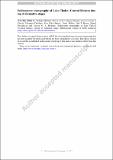| dc.contributor.author | Martínez-Abarca, Rodrigo | |
| dc.contributor.author | Ortega-Guerrero, Beatriz | |
| dc.contributor.author | Lozano-García, Socorro | |
| dc.contributor.author | Caballero, Margarita | |
| dc.contributor.author | Valero-Garcés, Blas | |
| dc.contributor.author | Brown, Erik T. | |
| dc.contributor.author | Stockhecke, Mona | |
| dc.contributor.author | Hodgetts, Alastair G. E. | |
| dc.contributor.author | Mcgee, David | |
| dc.date.accessioned | 2022-01-25T21:39:52Z | |
| dc.date.available | 2021-11-01T14:33:56Z | |
| dc.date.available | 2022-01-25T21:39:52Z | |
| dc.date.issued | 2021-01 | |
| dc.date.submitted | 2020-04 | |
| dc.identifier.issn | 1437-3262 | |
| dc.identifier.issn | 1437-3254 | |
| dc.identifier.uri | https://hdl.handle.net/1721.1/136875.2 | |
| dc.description.abstract | Abstract
Lake Chalco lies south of the Basin of Mexico and has been the subject of studies related to Late Quaternary climate variability. In 2016, the International Continental Scientific Drilling Program “MexiDrill Project” recovered a 520-m sediment record from Lake Chalco. Magnetic susceptibility measurements revealed substantial changes in sediment physical properties between 343 and 285 m depth, suggesting changes in composition associated with fluctuations in the depositional environment. We targeted sediments in the 343–285 m interval for high-resolution facies analysis, to develop a model of Lake Chalco formation. We identified three facies associations, using sediment composition, texture, mineralogy and micro-morphological characteristics: (1) detrital facies, consisting of laminated silt, massive sand, stratified silty sand, clast-supported gravel and matrix-supported gravel; (2) biogenic facies, which include diatom ooze and bivalve coquina; and (3) volcaniclastic facies, represented by clast-supported pumice deposits. We propose that formation of Lake Chalco occurred in four stages, which we identified by changes in sediment characteristics. The first stage was an alluvial delta environment, in which debris and hyper-concentrated flows were the main sediment transport agents. The second was characterized by turbulent flows in a fluvial deltaic environment, which alternated with laminar flows associated with floodplains. The third stage was a time of fluvio-lacustrine transition in the basin, with formation of the previously identified Paleo-Chalco-I Lake, in response to wet conditions. During the fourth stage, a deep eutrophic lake formed (Paleo-Chalco-II), with an origin that appears to have been related to regional volcanism. Our working age-depth model indicates establishment of the lake at ca. 400 ± 46 ka. This paper presents the only available record of the transition from alluvial to lacustrine sedimentation of Lake Chalco. Our results allow us to establish (1) how the lake was formed and what the phases of its development were, (2) how a major volcanic event altered and transformed the lacustrine sedimentation, and (3) which climatic conditions dominated during the lake formation. The age for the onset of the lacustrine sedimentation in Chalco is for the first time constrained to around 400 ka. This enables to expand our knowledge of the climate for a time for which there is no information from terrestrial records of tropical North America. | en_US |
| dc.publisher | Springer Berlin Heidelberg | en_US |
| dc.relation.isversionof | https://doi.org/10.1007/s00531-020-01964-z | en_US |
| dc.rights | Creative Commons Attribution-Noncommercial-Share Alike | en_US |
| dc.rights.uri | http://creativecommons.org/licenses/by-nc-sa/4.0/ | en_US |
| dc.source | Springer Berlin Heidelberg | en_US |
| dc.title | Sedimentary stratigraphy of Lake Chalco (Central Mexico) during its formative stages | en_US |
| dc.type | Article | en_US |
| dc.contributor.department | Massachusetts Institute of Technology. Department of Earth, Atmospheric, and Planetary Sciences | |
| dc.relation.journal | International Journal of Earth Sciences | en_US |
| dc.eprint.version | Author's final manuscript | en_US |
| dc.type.uri | http://purl.org/eprint/type/JournalArticle | en_US |
| eprint.status | http://purl.org/eprint/status/PeerReviewed | en_US |
| dc.date.updated | 2021-09-04T03:17:58Z | |
| dc.language.rfc3066 | en | |
| dc.rights.holder | Geologische Vereinigung e.V. (GV) | |
| dspace.embargo.terms | Y | |
| dspace.date.submission | 2021-09-04T03:17:58Z | |
| mit.journal.volume | 110 | en_US |
| mit.license | OPEN_ACCESS_POLICY | |
| mit.metadata.status | Authority Work Needed | en_US |
